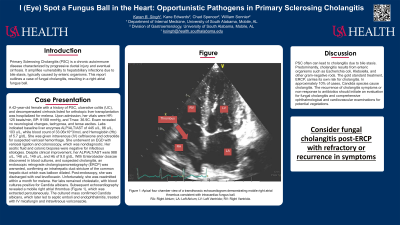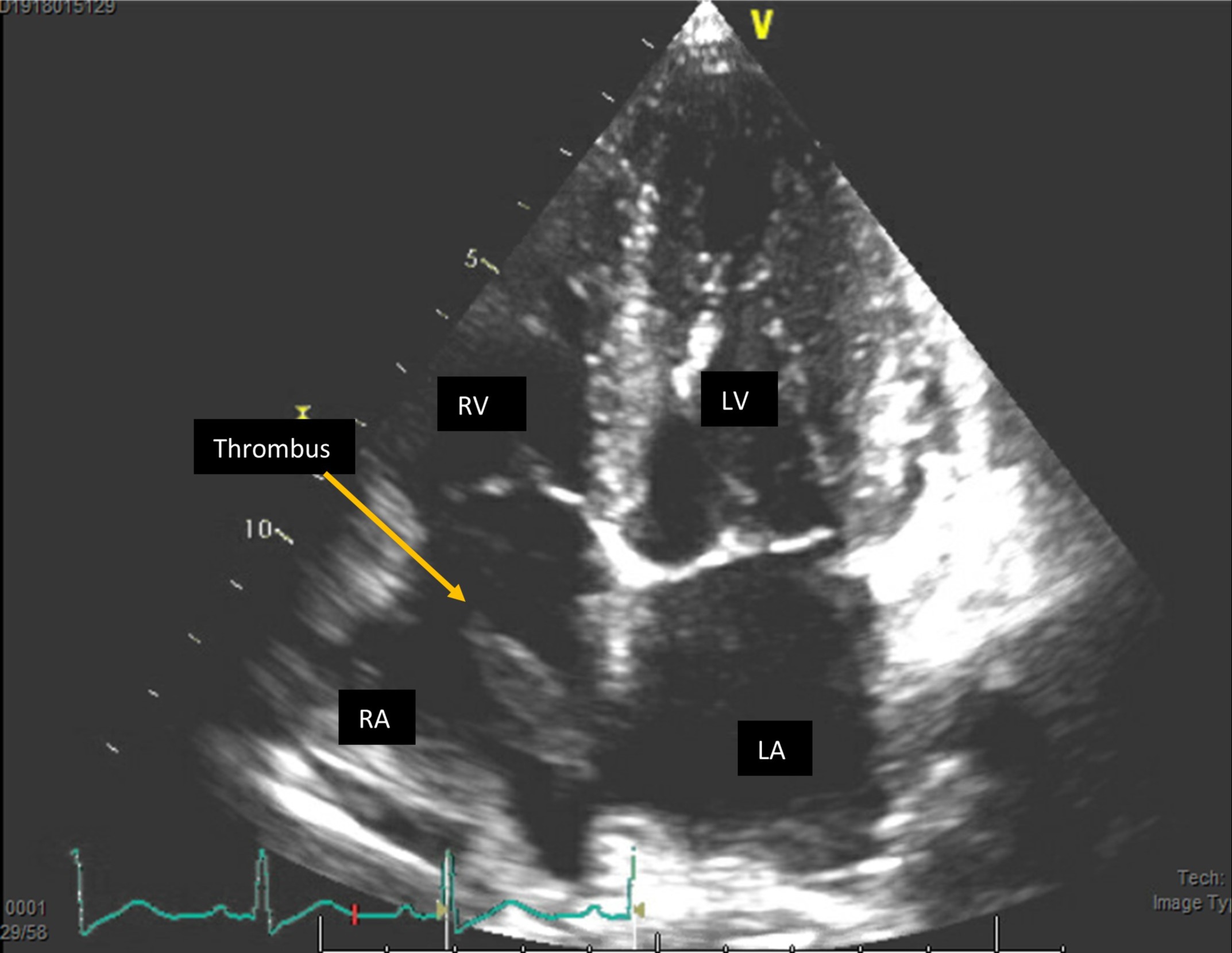Monday Poster Session
Category: Biliary/Pancreas
P1549 - I (Eye) Spot a Fungus Ball in the Heart: Opportunistic Pathogens in Primary Sclerosing Cholangitis
Monday, October 23, 2023
10:30 AM - 4:15 PM PT
Location: Exhibit Hall

Has Audio

Karan B. Singh, MD
University of South Alabama
Mobile, AL
Presenting Author(s)
Karan B. Singh, MD1, Kane Edwards, MD2, Chad Spencer, MD1, William Sonnier, MD3
1University of South Alabama, Mobile, AL; 2USA Health, Mobile, AL; 3University of South Alabama College of Medicine, Mobile, AL
Introduction: Primary Sclerosing Cholangitis (PSC) is a chronic autoimmune disease characterized by progressive ductal injury and eventual cirrhosis. It amplifies vulnerability to hepatobiliary infections due to bile stasis, typically caused by enteric organisms. This report outlines a case of fungal cholangitis, resulting in a right atrial fungus ball.
Case Description/Methods: A 42-year-old female with a history of PSC, ulcerative colitis (UC), and decompensated cirrhosis listed for orthotopic liver transplantation was hospitalized for melena. Upon admission, her vitals were HR: 125 beats/min, BP: 91/68 mmHg, and Tmax: 36.9C. Exam revealed no neurological changes, tachypnea, and tense ascites. Labs indicated baseline liver enzymes ALP/ALT/AST of 445 u/L, 86 u/L, 103 u/L, white blood count of 33.06x10^3/mcl, and Hemoglobin (Hb) of 5.7 g/dL. She was given intravenous (IV) ceftriaxone and octreotide for suspected variceal hemorrhage. She underwent an EGD with variceal ligation and colonoscopy, which was nondiagnostic. Her ascitic fluid and colonic biopsies were negative for infectious etiologies. Despite clinical improvement, her ALP/ALT/AST were 988 u/L, 148 u/L, 149 u/L, and Hb of 9.0 g/dL. With Enterobacter cloacae discovered in blood cultures, and suspected cholangitis, an endoscopic retrograde cholangiopancreatography (ERCP) was warranted, confirming an intrahepatic duct stricture of the common hepatic duct which was balloon dilated. Post-endoscopy, she was discharged with oral levofloxacin. Unfortunately, she was readmitted within a month for melena. Her labs remained cholestatic, with blood cultures positive for Candida albicans. Subsequent echocardiography revealed a mobile right atrial thrombus (Figure 1), which was extracted percutaneously. The cultured mass confirmed Candida albicans, which later led to septic emboli and endophthalmitis, treated with IV micafungin and intravitreous voriconazole.
Discussion: PSC often can lead to cholangitis due to bile stasis. Predominantly, cholangitis results from enteric organisms such as Escherichia coli, Klebsiella, and other gram-negative rods. The gold standard treatment, ERCP, carries its own risk for cholangitis. In approximately 10% of cases, Candida species cause cholangitis. The recurrence of cholangitis symptoms or non-response to antibiotics should initiate an evaluation for fungal cholangitis and comprehensive ophthalmological and cardiovascular examinations for potential vegetations.

Disclosures:
Karan B. Singh, MD1, Kane Edwards, MD2, Chad Spencer, MD1, William Sonnier, MD3. P1549 - I (Eye) Spot a Fungus Ball in the Heart: Opportunistic Pathogens in Primary Sclerosing Cholangitis, ACG 2023 Annual Scientific Meeting Abstracts. Vancouver, BC, Canada: American College of Gastroenterology.
1University of South Alabama, Mobile, AL; 2USA Health, Mobile, AL; 3University of South Alabama College of Medicine, Mobile, AL
Introduction: Primary Sclerosing Cholangitis (PSC) is a chronic autoimmune disease characterized by progressive ductal injury and eventual cirrhosis. It amplifies vulnerability to hepatobiliary infections due to bile stasis, typically caused by enteric organisms. This report outlines a case of fungal cholangitis, resulting in a right atrial fungus ball.
Case Description/Methods: A 42-year-old female with a history of PSC, ulcerative colitis (UC), and decompensated cirrhosis listed for orthotopic liver transplantation was hospitalized for melena. Upon admission, her vitals were HR: 125 beats/min, BP: 91/68 mmHg, and Tmax: 36.9C. Exam revealed no neurological changes, tachypnea, and tense ascites. Labs indicated baseline liver enzymes ALP/ALT/AST of 445 u/L, 86 u/L, 103 u/L, white blood count of 33.06x10^3/mcl, and Hemoglobin (Hb) of 5.7 g/dL. She was given intravenous (IV) ceftriaxone and octreotide for suspected variceal hemorrhage. She underwent an EGD with variceal ligation and colonoscopy, which was nondiagnostic. Her ascitic fluid and colonic biopsies were negative for infectious etiologies. Despite clinical improvement, her ALP/ALT/AST were 988 u/L, 148 u/L, 149 u/L, and Hb of 9.0 g/dL. With Enterobacter cloacae discovered in blood cultures, and suspected cholangitis, an endoscopic retrograde cholangiopancreatography (ERCP) was warranted, confirming an intrahepatic duct stricture of the common hepatic duct which was balloon dilated. Post-endoscopy, she was discharged with oral levofloxacin. Unfortunately, she was readmitted within a month for melena. Her labs remained cholestatic, with blood cultures positive for Candida albicans. Subsequent echocardiography revealed a mobile right atrial thrombus (Figure 1), which was extracted percutaneously. The cultured mass confirmed Candida albicans, which later led to septic emboli and endophthalmitis, treated with IV micafungin and intravitreous voriconazole.
Discussion: PSC often can lead to cholangitis due to bile stasis. Predominantly, cholangitis results from enteric organisms such as Escherichia coli, Klebsiella, and other gram-negative rods. The gold standard treatment, ERCP, carries its own risk for cholangitis. In approximately 10% of cases, Candida species cause cholangitis. The recurrence of cholangitis symptoms or non-response to antibiotics should initiate an evaluation for fungal cholangitis and comprehensive ophthalmological and cardiovascular examinations for potential vegetations.

Figure: Figure 1: Apical four-chamber view of a transthoracic echocardiogram demonstrating mobile right atrial thrombus consistent with intracardiac fungus ball.
RA: Right Atrium; LA: Left Atrium; LV: Left Ventricle; RV: Right Ventricle.
RA: Right Atrium; LA: Left Atrium; LV: Left Ventricle; RV: Right Ventricle.
Disclosures:
Karan Singh indicated no relevant financial relationships.
Kane Edwards indicated no relevant financial relationships.
Chad Spencer indicated no relevant financial relationships.
William Sonnier: Abbvie – Speakers Bureau.
Karan B. Singh, MD1, Kane Edwards, MD2, Chad Spencer, MD1, William Sonnier, MD3. P1549 - I (Eye) Spot a Fungus Ball in the Heart: Opportunistic Pathogens in Primary Sclerosing Cholangitis, ACG 2023 Annual Scientific Meeting Abstracts. Vancouver, BC, Canada: American College of Gastroenterology.
